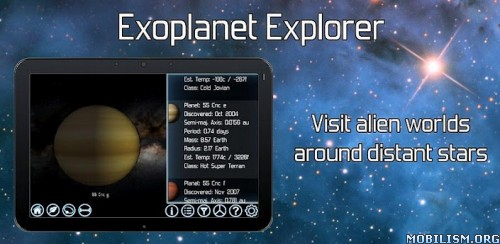Requirements: Android 2.2+
Overview: Take a journey into deep space to visit alien worlds around distant stars

Exoplanet Explorer takes you on a journey into deep space, beyond the limits of our Solar System. Based on the latest available data, you'll explore virtual models of more than 700 known planets and the star systems that they inhabit.
The full version of Exoplanet Explorer 2 introduces a feature that will automatically download the latest planetary discoveries, keeping you up to date. For the first time it also includes models of some of the binary star systems that are known to have planets, giving you a much better idea of the variety of different worlds in our Galaxy.
The data is sourced from The Exoplanet Encyclopaedia, SIMBAD, and scientific papers, and if it's not available from one of these sources, then wherever possible it will be calculated or estimated, giving you access to one of the most complete exoplanet databases.
In addition to an intuitive interface which allows touch driven navigation through our Galaxy, Exoplanet Explorer also offers a comprehensive search tool which will let you find the planets and systems that you are interested in. This includes the ability to both search and sort by planet name, the number of planets in a system or even then number of stars in a system, to name just a few.
Statistics are provided to summarise the information in the database and give you a global perspective.
Planets have been divided up into 6 classes, and further subdivides into 3 temperature classes. This information has then been used to create models which are then assembled into working solar systems to give you an idea of what they might look like if we could travel there today.
Planet are divided into the following mass classes:
* Mercurian - rocky worlds that have the approximate mass of Mercury
* Sub-terran - rocky planets with a mass similar to Mars
* Terran - rocky worlds with similar mass to Earth
* Super-terran - rocky worlds with a higher mass than Earth
* Neptunian - gas giants similar to Neptune
* Jovian - gas giants as massive or more massive than Jupiter
The planets are further divided into the following temperature classes:
* Hot - planets that are too hot to support liquid water
* Warm - planets in the star's habitable zone where liquid water could exist
* Cold - planets beyond the habitable zone where water would only exist as ice
What's in this version:
Glossary of terms
Bug fixes
This app has no advertisements
More Info:





